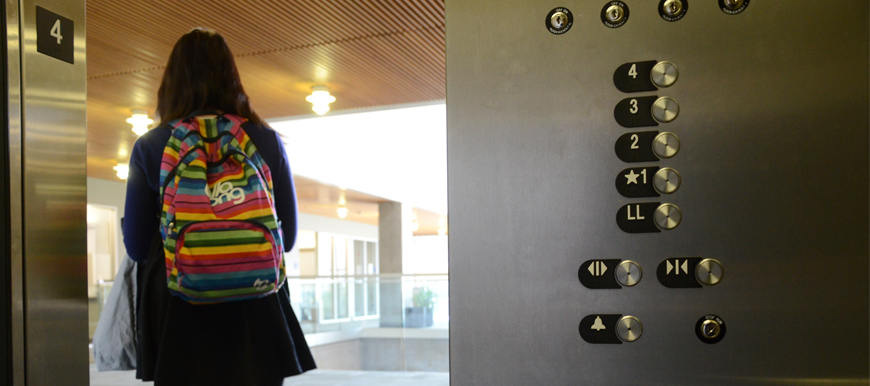Need a lift? The ups and downs of elevator etiquette
Elevator etiquette is an unspoken code, which can result in glares and an uncomfortable ride from floor-to-floor.
The social cues for using elevator etiquette can be unclear. Yet, not following a few simple steps — especially in dorms— can lead to problems.
Mason Meyers, a freshman studying technology and engineering education, said the first step is to make sure everyone who is exiting has left the elevator before a new person or group gets on.
“The first thing would be when people start trying to get on before you get off,” Meyers said. “You bump into each other, and it’s awkward.”
Carly Antonetti, a freshman studying art history, sees issues with this as well.
“Whenever you get on or off, everyone either moves clockwise or counterclockwise so that a new rotation of people can enter,” Antonetti said. “People leave first before new people get on, as per social etiquette. It’s just the polite thing to do.”
While using the elevator, it’s also important to be aware of the ultimate destination and determine whether an elevator trip is really necessary.
“If you live on the second floor, then you should walk up the stairs because, A, it’s healthier for you and, B, it’s faster,” said Jennifer Schone, a freshman studying elementary education.
Meyers said there are exceptions to this rule, but there needs to be a valid reason.
“If you have a bunch of groceries and laundry or whatever or you broke your leg snowboarding, take the elevator,” Meyer said. “But if not, just take one flight of stairs. If you were in the TSC, you wouldn’t take the elevator from The Hub to the Marketplace. You would go up the stairs. Why wouldn’t you do the same thing in a dorm?”
To prevent this, some people have taken the issue into their own hands.
“My neighbor was going down to class, and it stopped on the second floor, and this kid started to walk on,” Meyers said.
Meyers said his neighbor proceeded to tell the oncoming student that he was not getting on the elevator and closed the doors.
Schone said it is more reasonable to take the elevator when going up or down two or more flights.
“If you’re going more than one floor, it’s fine. I don’t care,” she said.
She said those extra steps might prevent some awkward run-ins.
“Stairs are good for you,” Meyers said. “Good cardio, good leg workout, so going up 10 stairs really wouldn’t be the worst for you.”
Another step is to ensure that you alert the person closest to the buttons on which floor you want to get off.
“Proper social etiquette dictates that the person nearest the buttons is going to ask anyone who gets on if the floor they want has been selected,” Antonetti said, “and if not, they select it for them.”
Though this might seem like a common step, he said it’s often ignored.
“There’s a very large group of girls that live on the second floor,” Antonetti said. “And every Friday night they go and get fast food. And every Friday night, I take my garbage out. I’m always on the elevator on the first floor, and I hold the door for them because I’m polite, because why not? They never tell me they want me to push the second floor button, and then when we pass the second floor they all stare at me like I should’ve known and go complain, ‘That was our floor.’ It’s not my job to know where you live.”
When taking the elevator, Antonetti said is important to remember these steps, which make it a more enjoyable and quicker experience.
— sadiejherrera@aggiemail.usu.edu

